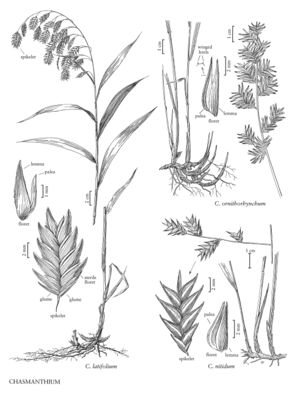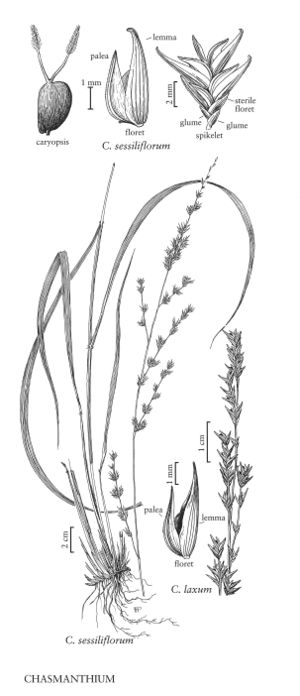Chasmanthium
Plants perennial; cespitose or loosely colonial, rhizomatous. Culms 35-150 cm, simple or branched. Leaves cauline; ligules membranous, ciliate; blades not pseudopetiolate, flat. Panicles open or contracted, sometimes becoming racemose distally; disarticulation above the glumes and between the florets. Spikelets 4-50 mm, laterally compressed, with 2-many florets, lower 1-4 florets sterile. Glumes 2, subequal, shorter than the spikelets, glabrous, (2) 3-9-veined, acute to acuminate; lemmas glabrous, 3-15-veined, compressed-keeled, keels serrate or ciliate, apices acuminate to acute, entire (rarely bifid); paleas glabrous, gibbous basally, 2-keeled, keels winged, wings glabrous, scabrous, or pilose; lodicules 2, fleshy, cuneate, 2-4-veined, lobed-truncate; anthers 1; ovaries glabrous; styles 2; style-branches 2, plumose, reddish-purple at anthesis. Caryopses 1.9-5 mm, laterally compressed, brown to reddish-black or black, x = 12.
Distribution
Del., Wis., W.Va., Fla., N.J., Tex., La., N.C., Tenn., S.C., Pa., N.Y., D.C, N.Mex., Va., Ala., Ark., Ill., Ga., Ind., Iowa, Ariz., Md., Kans., Okla., Ohio, Mo., Mich., Miss., Ky.
Discussion
Chasmanthium, a genus of five species endemic to North America, grows primarily in the southeastern and south-central parts of the United States. It was formerly included in Uniola, but it is now recognized as a distinct genus.
Selected References
Lower Taxa
Key
| 1 | Panicle branches nodding or drooping; pedicels 10-30 mm long; calluses pilose; lower glumes 4.2-9.1 mm long; keels of fertile lemmas winged, the wings scabrous to pilose their full length; caryopses 2.9-5 mm long | Chasmanthium latifolium |
| 1 | Panicle branches erect or ascending; pedicels 0.5-2.5(5) mm long; calluses glabrous; lower glumes 1.2-5 mm long; keels of fertile lemmas not winged, scabridulous toward or at the apices; caryopses 1.9-3 mm long. | > 2 |
| 2 | Spikelets 9.5-24 mm long; fertile lemmas 9-13-veined; caryopses enclosed at maturity; blades 7-16(33) cm long, lanceolate-fusiform; culms leafy for 80% of their height. | > 3 |
| 3 | Axils of the panicle branches scabrous; fertile florets diverging to 45° from the rachilla; sterile florets (0)1(2); lower glumes 3.1-5 mm long, 7-9-veined; ligules entire | Chasmanthium nitidum |
| 3 | Axils of the panicle branches pilose; fertile florets diverging to 85° from the rachilla; sterile florets 2-4; lower glumes 2.5-2.9 mm long, 2-3-veined; ligules irregularly laciniate | Chasmanthium ornithorhynchum |
| 2 | Spikelets 4-10 mm long; fertile lemmas 3-9-veined; caryopses exposed at maturity; blades (8)20-50 cm long, linear-lanceolate; culms leafy for 40-50% of their height. | > 3 |
| 4 | Collars and sheaths pilose; culms (1)2-3.5 mm thick at the nodes; fertile lemmas 7-9-veined, usually curved or irregularly contorted | Chasmanthium sessiliflorum |
| 4 | Collars and sheaths glabrous; culms to 1 mm thick at the nodes; fertile lemmas 3-7-veined, straight | Chasmanthium laxum |
"wide" is not a number."decumbent" is not a number.

